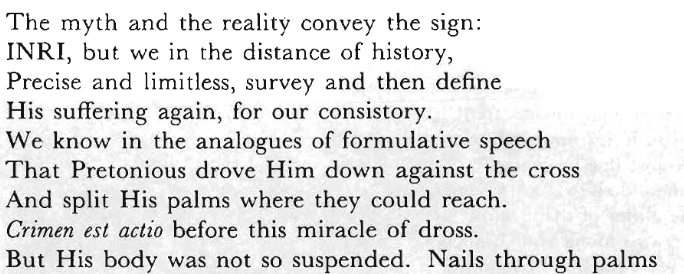Articles/Essays – Volume 03, No. 1
Crucifixion in Judea
The myth and the reality convey the sign:
INRI, but we in the distance of history,
Precise and limitless, survey and then define
His suffering again, for our consistory.
We know in the analogues of formulative speech
That Pretonious drove Him down against the cross
And split His palms where they could reach.
Crimen est actio before this miracle of dross.
But His body was not so suspended. Nails through palms
Cannot support the weight, as some medieval art might show,
For we know of Pierre Barbet, who proved it was not so
By nailing a freshly amputated arm and weighting it.
The Romans were the masters here, and so again
They drove the nails, with care and point,
To cause the greatest pain. At the wrist’s crease
There is a muscle over a structure of substantial bone,
And between the bones a little space: there, they said,
And there! to hold His weight, piercing the median nerve,
For He had been scourged and crowned and led to Calvary,
Then exposed, his robe against His skin with the blood
Of the flogging, flaying Him when ripped away to ready Him.
But that was less than the pain of nails fixed
And sinking in with hammer blows. Not a little nerve,
As one might feel in the valley of a wound, but for tides
Of pain, like an arm or leg cut off, that overwhelms
The muscles of the arms, neck, head, and chest
And causes them to pull and cramp in the rage
Of agony. Then the crosspiece was raised and pulled
To drag Him backwards on the ground before the tree,
And together they were lifted up to form the cross.
To stay the threshing legs from tearing Him free,
They drove the fixing nail into His feet.
The sinuous writhing came, in all His body, so He strained
Upward to keep His breath and ease the pain,
Fully standing on the nail. But only for a time.
Then he slumped, exhausted, hanging from the wrists.
Then the cycle of relief again, to strain again,
Through the hours of His torment, and then again.
So weakened in the Garden and then by this,
He sagged and failed against the pain, the muscles
Of His chest drawing in to still His heart and breath.
Who has forgotten the outrage of the crucifixion
In the tenor of the cloisters of gentle remembrance?
It was He who took all that men could give.
Receive Him as He gave Himself and so remember Him.


 Back to full Issue
Back to full Issue

